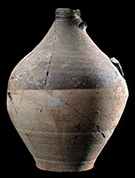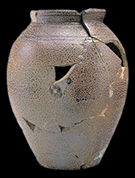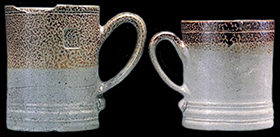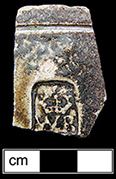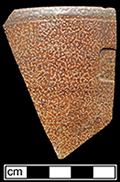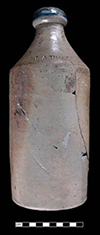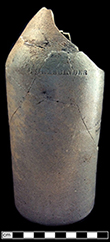Click on individual image to see larger view
North American Stoneware
--- Salt Glazed ---
Eighteenth-century Salt Glaze Stoneware Influenced by English Brown Stoneware
William Rogers,
Poor Potter of Yorktown
Photos courtesy of Chipstone Foundation and National Park Service, Colonial National Historical Park, Yorktown Collection.
18BC33 Federal Site
Feature 14 (filled c. 1830s with garbage from an earlier household)
Clagett’s Brewery 18BC38
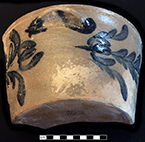

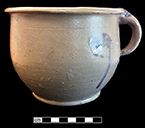
Grey bodied salt glaze stoneware bowl with
cobalt floral decoration. Cupped lug handle.
Vessel rim diameter: 12.00”,
Vessel height: 5.50”.
Grey bodied salt glaze stoneware bowl with
cobalt decoration. Flat base, sloping sides in
a pan form more common before 1860
(Greer 1981:97); Rim diameter: 9.50”,
Vessel height: 3.75”.
North American salt glazed stoneware
chamberpot, painted cobalt. Rim diameter:
7.75”, Base diameter: 5.00”, Vessel height: 6.00”. Lot: No lot number.
18BC27 Federal Reserve
Feature 42 Privy c. 1830s-1860s
18BC27 Federal Reserve
Feature 23 Well, Third quarter of
19th century

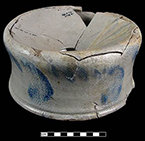



Grey-bodied salt glaze stoneware spittoon with cobalt scroll or leaf motif.
This vessel is virtually identical to a circa 1865 Pennsylvania example illustrated
in Schaltenbrand 1995:173.
Vessel diameter: 10.00”, Vessel height: 4.75”.
The upper exterior and the interior of this
vessel was coated with an iron oxide wash
or brown clay slip. Rim diameter: 4.00”.
18BC56 American Can Company
From fill deposited circa 1880-1890 at Harford Run


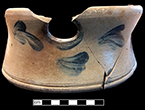
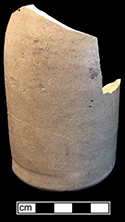
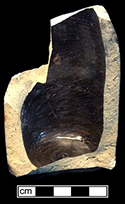
Grey bodied salt glaze stoneware milk
pan/bowl. This pan form, with a flat base
and sloping sides, was the “universal form
of bowl until after about 1860” (Greer
1981:97). The exterior and interior of this
vessel was coated with an iron oxide wash
or brown clay slip. This vessel has been
repurposed as a flower pot by having a hole
punched through its base. Rim diameter:
4.58”, Base diameter: 3.00”, Vessel
height: 4.50”. Vessel # 57
Grey-bodied salt glaze stoneware spittoon
with cobalt scroll or leaf motif. Vessel
diameter: 10.50”, Vessel height: 4.50”.
Lot #: 33-16, 17, 18, 19, 20. This vessel
is virtually identical to a circa 1865
Pennsylvania example illustrated in
Schaltenbrand 1995:173.
Grey bodied salt glazed stoneware bottle
with Albany slipped interior. Base
diameter: 2.50”. Lot #: 33-9.
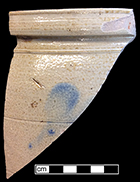

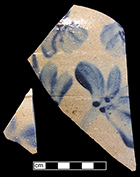
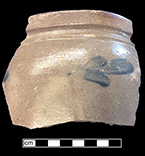

with indeterminate cobalt motif. Rim
diameter: 6.00, Vessel #: 24.
Grey-bodied salt glaze stoneware jar
with floral cobalt motif. Vessel
diameter: 6.00, Vessel #: 23.
Grey-bodied salt glaze stoneware jar
with leaf cobalt motif. Rim
diameter: 7.50”, Vessel #: 40.
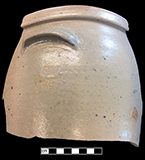

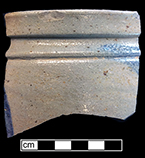

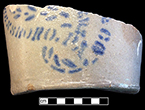
Grey-bodied salt glaze stoneware jar with lug
handle. Rim diameter:9.00”, Vessel #:28.
Grey-bodied salt glaze stoneware jar
with indeterminate cobalt motif. Rim
diameter: 5.50”, Vessel #: 30.
Grey-bodied salt glaze stoneware hollow
vessel with stencilled cobalt motif. Base
diameter: 5.75”, Vessel #:7. This vessel was
made in Greensboro, Pennsylvania by James
Hamilton Company, in business between
1850 and 1880 (Greer 1981:174).
18CV13 Brewhouse
Lot 2 � part of a large assemblage discarded under the house in the early 20th century and found during renovation.
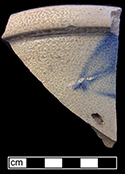

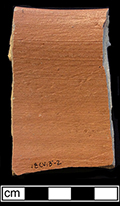
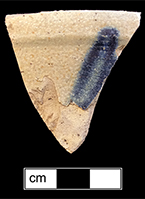
Grey bodied salt glazed stoneware crock or
jar with cobalt blue painting. Interior of
vessel has pale brown wash.
Rim diameter: 7.00”
Grey bodied salt glazed stoneware crock
or jar with cobalt blue painting. Interior
of vessel has orangeish brown wash. The
straight sides of this vessel suggest it was made
after circa 1850. Rim diameter: 7.00”
Grey bodied salt glazed stoneware crock
or jar with cobalt blue painting. Interior
of vessel has no wash. Rim diameter: 7.00”.
18PR175 Oxon Hill Plantation,
Area 1
Lense in side yard of Main House, possibly associated with Thomas Berry family (1812-1854)
or Thomas E. Berry family (1860-1888)


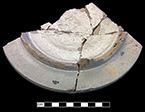

Top view Side view Bottom view Private Collection
Flat salt glaze stoneware cake pot lid with interior ledge. 12” rim diameter, 10” interior rim diameter.
Lid is similar to the one on cake crock shown on the right from a private collection. (Lot 1182)
18PR175 Oxon Hill Plantation,
Area 1
Feature 1001 Cellar filled between 1863 and c. 1895, possibly associated with
Thomas Berry family (1812-1854) or Thomas E. Berry family (1860-1888)
18QU124 Queenstown Courthouse
1708 to present
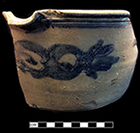
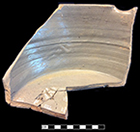
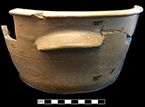
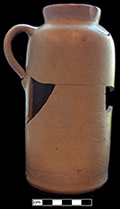
Grey bodied salt glaze stoneware bowl with cobalt decoration. Bowl with pulled spout
to facilitate pouring. Heavy potter’s
throwing
marks visible on the vessel
interior.
10.50” rim diameter,
9.50” base diameter. (Lot 2311)
Grey-bodied salt glaze stoneware bowl
with cupped lug handle. 11.50” rim
diameter, 9.0” base diameter. (Lot 2311)
North American pale grey-bodied salt
glazed handled jug. The straight sides and
definite shoulder on this vessel suggest that
it was made after circa 1850. Rim diameter: 2.75”, base diameter: 4.00”,
vessel height: 8.00”.
18MO609 Jackson Homestead
African-American farmstead of Malinda Jackson, burned c. 1915

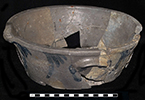

Grey bodied salt glazed stoneware bowl
with a pulled spout and cobalt blue painting.
Rim diameter: 9.75”, Vessel V-05.
Grey bodied salt glazed stoneware bowl
with a pulled spout and cobalt blue painting.
Vessel has two lug handles. Rim diameter:
11.00”, Vessel V-12.
Buff bodied jug. One
pint capacity. Albany
slip interior. The straight sides and definite
shoulder on this vessel suggest that it was
made after circa 1850. Vessel height: 8.00”, Vessel
body diameter: 3.00”, Vessel V-7.

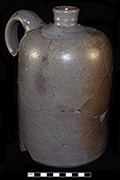

Grey bodied salt glaze stoneware jug. 1
quart capacity. The full bellied/ovoid form
of this jug was more common in the first half
of the nineteenth century (Greer 1981).
Vessel height: >7.00”, Vessel body
diameter: 4.50”, Vessel V-6.
Grey bodied salt glaze stoneware jug.
¾ gallon capacity. The straight sides and
definite shoulder on this vessel suggest that it
was made after circa 1850. Vessel hgt.: 10:00”, Vessel body diameter: 6.00”, Vessel V-11.
Grey bodied salt glaze stoneware jug with
missing handle. Vessel height: 9.50”, Vessel
body diameter: approximately 4.50”,
Vessel V-27.
Damaged by fire.


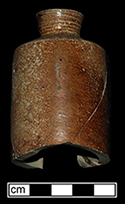
Buff bodied salt glaze stoneware handled jar
with incised parallel lines on shoulder. Iron
wash on interior and exterior. Strap handle.
Three gallon capacity. Vessel height: 15.00”,
Vessel rim diameter: 5.75”, Vessel base
diameter: 6.00”, Vessel V-19.
Grey bodied salt glaze stoneware jar with
lug handle. Rim diameter: approximately
6.00”, Base diameter: approximately 6.50”,
Vessel V-18.
Damaged by fire.
Buff bodied salt glaze stoneware bottle
with
iron wash. Possible ink bottle. Rim
diameter: 0.56”, Vessel V-25.
-sm.jpg)
-sm.jpg)
-sm.jpg)
-sm.jpg)
-sm.jpg)
-sm.jpg)
motif, iron oxide along rim and 3 incised
lines just above shoulder. Fragment in
cross section on right.
Fragment in cross section on right.
and three incised bands just above shoulder.
Fragment in cross section on right.
-sm.jpg)
-sm.jpg)
-sm.jpg)
-sm.jpg)
-sm.jpg)
-sm.jpg)
indeterminate motif. Broken lug handle
evident. Fragment in cross section on right.
Fragment in cross section on right.
Fragment in cross section on right.

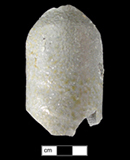
flask or jug) with a brown clay slip.
Pawley Kiln were not decorated.
--- Bristol Glaze and Albany Slip ---
18MO609 Jackson Homestead
African-American farmstead of Malinda Jackson, burned c. 1915
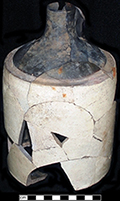
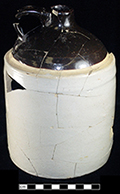
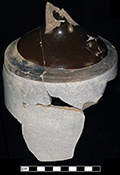
Buff bodied stoneware jug
with Albany
slipped shoulder, neck and
handle.
Bristol glaze covers the cylindrical
body. 2 quart capacity. Damaged from
burning. Vessel height: 9.00”,Vessel
diameter: 5.50”, Vessel V-16.
Buff bodied stoneware jug
with Albany
slipped shoulder, neck and
handle.
Bristol glaze covers the cylindrical
body. One gallon capacity. Vessel height:
8.00”, Vessel base diameter: 6.00”,
Vessel V-15.
Buff bodied stoneware jug
with Albany
slipped shoulder, neck and
handle. Bristol
glaze covers the cylindrical
body. Damaged
by burning. Vessel
diameter: 6.00”,
Vessel V-17.
Jugs or jars with sloping shoulders ending in a flat tooled ledge at the shoulder generally date after 1890 (Greer 1981:263).
18BC27 Federal Reserve
Feature 23 Well Third quarter of
19th century
18PR175 Oxon Hill Plantation
Area I
Private collection
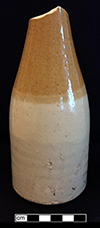

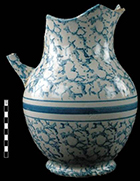
Tan bodied stoneware beer or ginger beer
bottle with white Bristol glaze on lower 2/3
of vessel and ferruginous slip on neck and
shoulders. Approximately 8” height, base diameter: 3.0”.
Grey bodied stoneware beer or ginger beer
bottle with a dark brown slip glaze of the
Albany type. Vessel height: 7.00”, base
diameter: 2/50”, MV 6051.
Jug with overall Bristol glaze with cobalt open sponge decoration and painted bands.
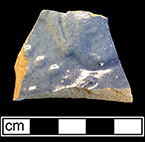

North American stoneware hollow form, probably large utilitarian bowl.
Bristol glaze on interior and blue ? exterior glaze. Lot 2
18CV13 Brewhouse
Lot 2 � part of a large assemblage discarded under the house in the early 20th century and found during renovation.
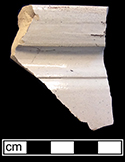




Buff bodied stoneware with
Bristol glaze
on exterior and Albany slip on
interior. Rim diameter: 7.00”
Buff bodied stoneware molded pie pan. Unglazed exterior, Albany
slipped interior
. Made in a jigger mold. Base of vessel has impressed/molded lettering
that reads
“Discoloration or Soaking of Crust”, Rim diameter: 10.00”, Vessel height: 1.50”.
--- Southern Alkaline Glaze ---
Private collection
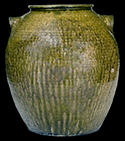

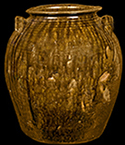
Ten-Gallon Alkaline-Glazed Stoneware Jar,
Possibly Daniel Seagle, Lincoln County, NC
origin, circa 1840, large-sized, rotund jar
with thin, semi-rounded rim, and curved lug
handles, the surface covered in a mottled
green alkaline glaze with heavier glaze runs
at the handle terminals.
Three-Gallon Alkaline-Glazed Stoneware
Jug, Stamped "JFS", James Franklin Seagle,
Vale, Lincoln County, NC, third quarter
19th
century, highly-ovoid jug with tooled
spout,
the surface covered in a streaky,
olive-green alkaline glaze.
North Carolina alkaline-glazed stoneware
five-gallon jar, late 19th century. This
vessel displays the drips and runs that
can characterize some alkaline glazes.
Vessel height: 14.25“.
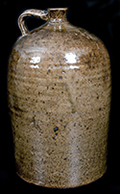

South Carolina alkaline-glazed stoneware
three-gallon cylindrical jug, circa 1880.
Stamped "W F HAHN / TRENTON / SC.
Vessel height: 15.75”
North Carolina brown alkaline glazed
stoneware churn with one strap handle
and
one lug handle. Late 19th century.
Vessel height: 18.50“.
31Rd1426 Squirrel Creek
Images used courtesy of the North Carolina Department of TransportationPhotos taken by Dovetail Cultural Resource Group

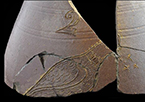
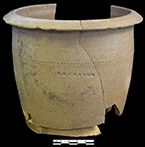

Brown bodied salt glaze stoneware pitcher
with incised bird with small x-shaped marks
in front the of the bird’s beak, resembling
insects. Vessel also marked with an incised
and stylized “2” for a two gallon capacity
mark. This vessel is believed to date to the
1840s or 1850s, based on the color and
decorative style (Hatch et al. 2017: 84).
The decoration on this vessel has been
attributed to the workshop of
Chester
Webster (1799 -1882).
Grey bodied salt glaze stoneware bowl
or milk pan with impressed maker’s mark
“E.S. Craven”. Enoch Craven (1810-1893)
likely started producing wares in the early
nineteenth century (Hatch et al. 2017: 81).
This pan form, with a flat base and sloping
sides, was the “universal form of bowl until
after about 1860” (Greer 1981:97).
Grey bodied salt glaze stoneware jug
or pitcher with impressed maker’s mark
“J.D. Craven” and rouletted 3 gallon
capacity mark. Jacob D. Craven
(1827-1895) produced pottery in
Randolph County until 1854 and then
moved to Moore County and made
pottery until his death (Hatch et al. 2017:81).
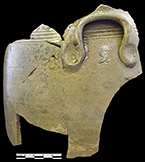
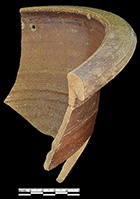
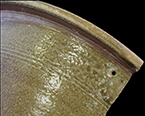
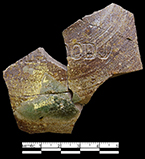
Grey bodied salt glaze stoneware jar
with impressed 2 gallon capacity mark
and lug handle.
Grey bodied salt glaze stoneware pan or
milk pan. Note the hole under the rim
that indicates a repair.
hollow vessel with partial maker’s mark.
Stamped mark “..ODY” stood for Alfred L.
Moody (1860 to 1924), a Randolph County
potter who likely started producing pottery in
the late-nineteenth century (Zug 1986:442).

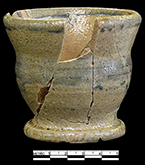

Grey bodied North Carolina Piedmont
salt glazed stoneware pitcher.
Grey bodied North Carolina Piedmont
salt glazed stoneware jar with cobalt banding.
Grey bodied North Carolina Piedmont
salt glazed stoneware plates.
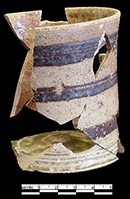
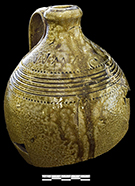
Grey bodied North Carolina Piedmont
salt glazed stoneware tankard with
iron oxides bands.
North Carolina Piedmont salt glazed
stoneware jug with rouletting, incised bands
and incised W. N. Craven mark. According
to North Carolina potter Hal Pugh, this vessel
appeared to have been salt glazed, but the
runny portions of the glaze are from ash
dripping in the kiln, creating an alkaline
glaze (Hatch et al. 2017).
Evolution of Jug Shapes

General evolution of jug shapes, showing change from ovoid to straight sided forms. Redrawn from Guilland 1971.
Back to: Top | Ware Essay
